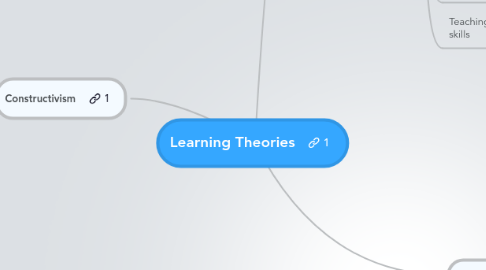
1. Constructivism
1.1. Jean Piaget
1.1.1. Knowledge is actively constructed by the mind of the learner
1.1.2. Knowledge is constructed from experience (accommodation and assimilation)
1.1.3. Piaget's active learner - The organism as constructive agent or knower
1.1.3.1. Behavioural Factors
1.1.3.2. Cultural Factors
1.1.3.3. Biological Factors
1.1.3.4. Social Factors
1.2. Learning is a personal interpretation of the world
1.3. Learning is an active process in which meaning is developed on the basis of experience
1.4. Kolb's Cycle of Experimental Learning
1.4.1. Active Experimentation
1.4.2. Concrete Experience
1.4.3. Reflective Observation
1.4.4. Abstract Conceptualization
1.5. Social Constructivism
1.5.1. Jean Piaget - Learning happens best when it is interactive
1.5.2. Seymour Papert of MIT Media Lab: learning happens best in a context where the learner is consciously engaged in constructing a public entity
1.5.3. Conceptual growth comes from:
1.5.3.1. the social negotiation of meaning
1.5.3.2. the sharing of multiple perspectives
1.5.3.3. the changing of our internal representations through collaborative learning
1.5.4. Teaching and ICTs
1.5.4.1. Learning should be situated in realistic settings
1.5.4.2. Testing should be integrated with the task and not a separate activity
1.5.4.3. Teachers guide and facilitate: Not impose
1.5.4.4. Methods and materials must be available to suit individual learning styles / potential
1.5.4.5. Learning activities should be collaborative, with a group construction of knowledge
1.5.4.6. These group constructions create a small organizational culture of shared artifacts, with shared meanings (Community of Practice)
1.5.5. Social Negotiation of Meaning
1.5.6. Salmon Model
1.5.6.1. Access and motivation
1.5.6.2. Online socialisation
1.5.6.3. Information exchange
1.5.6.4. Knowledge construction
1.5.6.5. Development
1.5.7. Active Learning
1.5.7.1. Zone of Proximal Development
1.5.7.2. the difference between what a learner can do without help and what he or she can do with help
1.5.7.3. Scaffolding is a more modern term
1.5.7.4. guided learning via focused questions and positive interactions
1.6. Teacher role: guide, facilitator of academic tasks
1.7. Student role: sense maker, knowledge constructor
1.8. Teaching method: learning by finishing academic tasks, experiencing, discovering, exploring problems
2. Behaviorism
2.1. Learning perspective
2.2. Learning is the acquisition of new behavior through conditioning
2.3. Environment shapes behavior
2.4. Association - learning links between our behavior and the reinforcement (reward or punishment
2.5. Focus on a new behavioral pattern being repeated until it becomes automatic
2.6. The Skinner Box experiment
2.7. Teaching and ICTs
2.7.1. Teaching is behavior modification
2.7.2. A Behaviorist approach breaks a task down into a series of simple steps
2.7.3. Management of class behavior is important
2.7.4. A variety of reinforcements to change student behavior
2.7.5. Drill and practice software: "programmed instruction" rewards a correct answer
2.7.6. Tutorial software to make learning efficient, especially memorizing basics
2.8. Teacher role: dispenser of reward or punishment
2.9. Student role: recipient of reward or punishment
2.10. Teaching method: drilling, practicing basic skills
3. Cognitivism
3.1. Jean Piaget - learners build internal conceptual frameworks (schemas)
3.2. Theory based on the thought process behind the behavior
3.3. Changes in behavior are observed, but only as an indicator to what is going on in the learner's head
3.4. The memory system is an active, organized processor of information
3.5. Prior knowledge plays an important role in learning
3.6. Atkinson-Shiffrin model:
3.6.1. Stimulus Event
3.6.2. Sensory Memory
3.6.3. Short Term Memory
3.6.4. Long Term Memory
3.7. Teaching and ICTs
3.7.1. Asking interesting questions, use multi-media to attract attention of students, present content
3.7.2. Highlight important points and relate to existing knowledge
3.7.3. Practice exercises for moving knowledge from Short Term Memory to Long Term Memory
3.7.3.1. Rehearsal
3.7.3.2. Feedback
